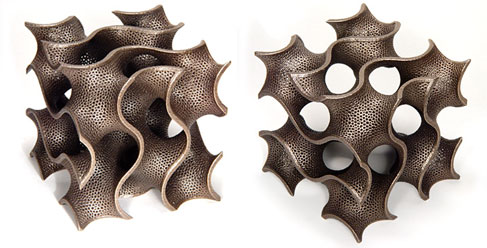
Gyroid sculpture
Posted on 01/09/2017 6:01:59 PM PST by 2ndDivisionVet
Through studying the geometry of strong structures, MIT researchers are now one step closer to 3D printing graphene. By comparison, 2D graphene is better at conducting electricity than copper wires, ten times stronger than steel, and lighter and certainly more transparent than both of them. The problem is that these properties as are all theoretical and scaling the nanomaterial has proved challenging. Furthermore, in order to compete with copper and steel, graphene has to be 3D.
3D graphene – here’s the deal
The challenges of making a 3D structure out of a 2D material is that the material’s atomic structure, the source of all its power, is changed through production methods, i.e. melting and cooling in 3D printing. Currently, graphene is used to strengthen other materials such as TPU or PLA.
MIT’s most recent research into The mechanics and design of a lightweight three-dimensional graphene assembly puts forward a possible geometric structure for graphene, providing its atomic structure prints unchanged. The geometry takes the form of gyroid, a shape first discovered by mathematician Alan Schoen in 1970.
Geometry is key
Gyroids are similar to the honeycomb structure of graphene itself in that their entire lattice can be created from just one segment of it, i.e. all you need to recreate a graphene lattice, is one hexagon.
Gyoroids are also characterised by their minimal surface, meaning that it takes on the form of ‘the least amount of area needed to occupy space’. This lends the shape to 3D printing as it means that it requires less material to make a shape of a particular volume cutting out waste and also weight, which is one of the main reasons for studying graphene’s 3D possibilities.
Tensile and compression tests
MIT 3D printed five gyroids with varying wall thickness. They were made in Stratasys’ VeroMagenta plastic on an Object500, at a resolution of 20 μm (microns or micromemters, a single unit being one thousandth of a millimetre), and then each tested for tensile (stretched) and compressive (squashed) strength.
(VIDEO-AT-LINK)
Results showed that gyroids with thicker walls behaved differently under pressure in comparison to thinner counterparts – the thin structures crumble gradually, whereas thick walls absorb the pressure and release it in an explosion.
The result of these tests enabled the researchers to digitally simulate how a gyroid made from graphene would perform under such stresses, as explained by lead author Markus Buehler, “You can replace the material itself with anything. The geometry is the dominant factor. It’s something that has the potential to transfer to many things.”
The simulations outline the potential limits of 3D graphene, establishing the “critical densities below which the 3D graphene assembly starts to lose its mechanical advantage over most polymeric cellular materials”. Though it still isn’t quite the 3D printed realisation we were hoping for, theory is of course the necessary informant of practice. 3DPI are looking forward to seeing the eventual result of such research – a 3D printed material stronger than an other in the world.
study
How does one invest in graphene?
Just make sure one of you guys lets me know when it’s time to buy 3D stock.
Companies really have zoomed since inception.
Now in English for the scientifically challenged.
Put me on that list too.
Like most industrial advances, while there will be startups that do very well, the bulk of the real money is going to be made by incorporating the new technology by existing companies. For example, GE is currently 3D-printing turbine blades. No startup has the capital or expertise to get into that market.
That’s what I’ve suspected all along.

Gyroid sculpture

Exactly. They just SIT there.
Was that the worst nerd joke ever? :)
For Brian.
ETF. Interesting. It is MUCH better than trying to pick the winning one or two out of many.
Thanks. I will do DD.
I bought a RepRap based 3-D Printer which required very little assembly two months ago. It has been great. There was and still is a bit of a learning curve with the 3D Design software and figuring out the best settings and prep for various types of filament.
PLA is extremely easy to work with. ABS is a little trickier. The strongest filament that I have purchased and used so far is nylon based and it is quite amazing. There is an incredible variety of filaments now available with properties that can meet a wide variety of requirements.
If one wants to learn about 3D Printing... I think that you will not get a good perspective until after you purchase one and get your hands dirty. At this point it is still not a plug and play activity. The one that I purchased was less than $300. And gives great results.
So if there are an estimated 89 million gun owners and each one owns an average of 8.1 guns... something isn’t adding up.
Sounds like a skewed data set.
Read a story one time about the strongest possible material called “Nothing”. Went on the premise that nothing ever tears on the perforated lines provided, so if one were to keep adding perforations until there was nothing left, you would have the strongest and lightest material ever....
Big help for those of us whose mental processes are fundamentally visual!
Wish I had those in 3-axis manipulable graphics; I believe I perceive an assembly structure organization that could result in microchannel plates for image intensifiers...
Disclaimer: Opinions posted on Free Republic are those of the individual posters and do not necessarily represent the opinion of Free Republic or its management. All materials posted herein are protected by copyright law and the exemption for fair use of copyrighted works.